NCERT Solution for Class 9 Mathematics Chapter 9 - Areas of Parallelograms and Triangles Page/Excercise 9.1
Question 1
Which of the following figures lie on the same base and between the same parallels. In such a case, write the common base and the two parallels. 

 (i) (ii) (iii)
(i) (ii) (iii) 
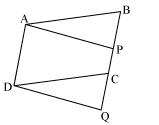
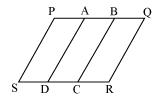 (iv) (v) (iv)
(iv) (v) (iv)


 (i) (ii) (iii)
(i) (ii) (iii) 

 (iv) (v) (iv)
(iv) (v) (iv)
Solution 1
(i)  Yes. Trapezium ABCD and triangle PCD are having a common base CD and these are lying between the same parallel lines AB and CD. (ii)
Yes. Trapezium ABCD and triangle PCD are having a common base CD and these are lying between the same parallel lines AB and CD. (ii)  No. The parallelogram PQRS and trapezium MNRS are having a common base RS but their vertices (i.e. opposite to common base) P, Q of parallelogram and M, N of trapezium are not lying on a same line. (iii)
No. The parallelogram PQRS and trapezium MNRS are having a common base RS but their vertices (i.e. opposite to common base) P, Q of parallelogram and M, N of trapezium are not lying on a same line. (iii) Yes. The Parallelogram PQRS and triangle TQR are having a common base QR and they are lying between the same parallel lines PS and QR. (iv)
Yes. The Parallelogram PQRS and triangle TQR are having a common base QR and they are lying between the same parallel lines PS and QR. (iv)  No. We see that parallelogram ABCD and triangle PQR are lying between same parallel lines AD and BC but these are not having any common base. (v)
No. We see that parallelogram ABCD and triangle PQR are lying between same parallel lines AD and BC but these are not having any common base. (v) Yes. We may observe that parallelogram ABCD and parallelogram APQD have a common base AD and also these are lying between same parallel lines AD and BQ. (vi)
Yes. We may observe that parallelogram ABCD and parallelogram APQD have a common base AD and also these are lying between same parallel lines AD and BQ. (vi) No. We may observe that parallelogram PBCS and PQRS are laying on same base PS, but these are not between the same parallel lines.
No. We may observe that parallelogram PBCS and PQRS are laying on same base PS, but these are not between the same parallel lines.
 Yes. Trapezium ABCD and triangle PCD are having a common base CD and these are lying between the same parallel lines AB and CD. (ii)
Yes. Trapezium ABCD and triangle PCD are having a common base CD and these are lying between the same parallel lines AB and CD. (ii)  No. The parallelogram PQRS and trapezium MNRS are having a common base RS but their vertices (i.e. opposite to common base) P, Q of parallelogram and M, N of trapezium are not lying on a same line. (iii)
No. The parallelogram PQRS and trapezium MNRS are having a common base RS but their vertices (i.e. opposite to common base) P, Q of parallelogram and M, N of trapezium are not lying on a same line. (iii) Yes. The Parallelogram PQRS and triangle TQR are having a common base QR and they are lying between the same parallel lines PS and QR. (iv)
Yes. The Parallelogram PQRS and triangle TQR are having a common base QR and they are lying between the same parallel lines PS and QR. (iv)  No. We see that parallelogram ABCD and triangle PQR are lying between same parallel lines AD and BC but these are not having any common base. (v)
No. We see that parallelogram ABCD and triangle PQR are lying between same parallel lines AD and BC but these are not having any common base. (v) Yes. We may observe that parallelogram ABCD and parallelogram APQD have a common base AD and also these are lying between same parallel lines AD and BQ. (vi)
Yes. We may observe that parallelogram ABCD and parallelogram APQD have a common base AD and also these are lying between same parallel lines AD and BQ. (vi) No. We may observe that parallelogram PBCS and PQRS are laying on same base PS, but these are not between the same parallel lines.
No. We may observe that parallelogram PBCS and PQRS are laying on same base PS, but these are not between the same parallel lines.NCERT Solution for Class 9 Mathematics Chapter 9 - Areas of Parallelograms and Triangles Page/Excercise 9.2
Question 1
In the given figure, ABCD is parallelogram, AE  DC and CF
DC and CF  AD. If AB = 16 cm. AE = 8 cm and CF = 10 cm, find AD.
AD. If AB = 16 cm. AE = 8 cm and CF = 10 cm, find AD. 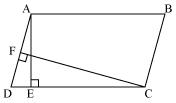
 DC and CF
DC and CF  AD. If AB = 16 cm. AE = 8 cm and CF = 10 cm, find AD.
AD. If AB = 16 cm. AE = 8 cm and CF = 10 cm, find AD. 
Solution 1
In parallelogram ABCD, CD = AB = 16 cm [Opposite sides of a parallelogram are equal]
We know that,
Area of parallelogram = Base corresponding attitude
corresponding attitude
Area of parallelogram ABCD = CD AE = AD
AE = AD  CF
CF
16 cm 8 cm = AD
8 cm = AD  10 cm AD =
10 cm AD =  cm = 12.8 cm. Thus, the length of AD is 12.8 cm.
cm = 12.8 cm. Thus, the length of AD is 12.8 cm.
We know that,
Area of parallelogram = Base
 corresponding attitude
corresponding attitude Area of parallelogram ABCD = CD
 AE = AD
AE = AD  CF
CF 16 cm
 8 cm = AD
8 cm = AD  10 cm AD =
10 cm AD =  cm = 12.8 cm. Thus, the length of AD is 12.8 cm.
cm = 12.8 cm. Thus, the length of AD is 12.8 cm.
Question 2
If E, F, G and H are respectively the mid-points of the sides of a parallelogram ABCD show that ar (EFGH) =  ar (ABCD)
ar (ABCD)
 ar (ABCD)
ar (ABCD)
Solution 2
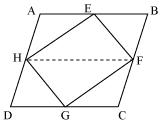 Construction: Join HF.
Construction: Join HF.In parallelogram ABCD
AD = BC and AD || BC (Opposite sides of a parallelogram are equal and parallel)
AB = CD [Opposite sides of a parallelogram are equal]

 AH = BF and AH || BF
AH = BF and AH || BF Since
 HEF and parallelogram ABFH are on the same base HF and between the same parallel lines AB and HF.
HEF and parallelogram ABFH are on the same base HF and between the same parallel lines AB and HF.  HEF) =
HEF) =  area (ABFH) ...(1) Similarly, we can prove area (
area (ABFH) ...(1) Similarly, we can prove area ( HGF) =
HGF) =  area (HDCF) ...(2) On adding equations (1) and (2), we have
area (HDCF) ...(2) On adding equations (1) and (2), we have 
Question 3
P and Q are any two points lying on the sides DC and AD respectively of a parallelogram ABCD. Show that ar (APB) = ar (BQC).
Solution 3
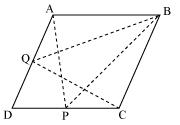 Here
Here  BQC and parallelogram ABCD lie on same base BC and these are between same parallel lines AD and BC.
BQC and parallelogram ABCD lie on same base BC and these are between same parallel lines AD and BC.  APB and parallelogram ABCD lie on the same base AB and between same parallel lines AB and DC
APB and parallelogram ABCD lie on the same base AB and between same parallel lines AB and DC area (
 BQC) = area (
BQC) = area ( APB)
APB)
Question 4
In the given figure, P is a point in the interior of a parallelogram ABCD. Show that
(i) ar (APB) + ar (PCD) =  ar (ABCD)
ar (ABCD)
(ii) ar (APD) + ar (PBC) = ar (APB) + ar (PCD)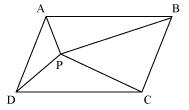
(i) ar (APB) + ar (PCD) =
 ar (ABCD)
ar (ABCD) (ii) ar (APD) + ar (PBC) = ar (APB) + ar (PCD)

Solution 4
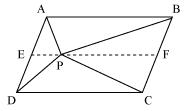 (i) Let us draw a line segment EF, passing through point P and parallel to line segment AB.
(i) Let us draw a line segment EF, passing through point P and parallel to line segment AB.In parallelogram ABCD we find that
AB || EF (By construction) ...(1)
ABCD is a parallelogram
AB || EF and AE || BF
So, quadrilateral ABFE is a parallelogram
Now, we may observe that
 APB and parallelogram AB || FE are lying on the same base AB and between the same parallel lines AB and EF.
APB and parallelogram AB || FE are lying on the same base AB and between the same parallel lines AB and EF.  PCD and parallelogram EFCD
PCD and parallelogram EFCD
area ( PCD) = area (EFCD) ... (4)
PCD) = area (EFCD) ... (4)
 PCD) = area (EFCD) ... (4)
PCD) = area (EFCD) ... (4)
Adding equations (3) and (4), we have

(ii)
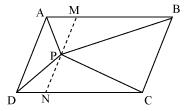 Draw a line segment MN, passing through point P and parallel to line segment AD.
Draw a line segment MN, passing through point P and parallel to line segment AD.In parallelogram ABCD we may observe that
MN || AD (By construction) ...(6)
ABCD is a parallelogram
MN || AD and AM || DN
So, quadrilateral AMND is a parallelogram Now,
 APD and parallelogram AMND are lying on the same base AD and between the same parallel lines AD and MN.
APD and parallelogram AMND are lying on the same base AD and between the same parallel lines AD and MN.  PCB and parallelogram MNCB
PCB and parallelogram MNCBarea (
 PCB) =
PCB) =  area (MNCB) ... (9)
area (MNCB) ... (9) Adding equations (8) and (9), we have

On comparing equations (5) and (10), we have
Area (
 APD) + area (
APD) + area ( PBC) = area (
PBC) = area ( APB) + area (
APB) + area ( PCD)
PCD)
Question 5
In the given figure, PQRS and ABRS are parallelograms and X is any point on side BR. Show that
(i) ar (PQRS) = ar (ABRS)
(ii) ar ( PXS) =
PXS) =  ar (PQRS)
ar (PQRS)
(i) ar (PQRS) = ar (ABRS)
(ii) ar (
 PXS) =
PXS) =  ar (PQRS)
ar (PQRS)
Solution 5
(i) Parallelogram PQRS and ABRS lie on the same base SR
and also these are in between same parallel lines SR and PB. (ii) Now consider
(ii) Now consider  AXS and parallelogram ABRS
AXS and parallelogram ABRS
As these lie on the same base and are between same parallel lines AS and BR
and also these are in between same parallel lines SR and PB.
 AXS and parallelogram ABRS
AXS and parallelogram ABRS As these lie on the same base and are between same parallel lines AS and BR

Question 6
A farmer was having a field in the form of a parallelogram PQRS. She took any point A on RS and joined it to points P and Q. In how many parts the field is divided? What are the shapes of these parts? The farmer wants to sow wheat and pulses in equal portions of the field separately. How should she do it?
Solution 6
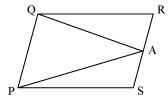 From figure it is clear that point A divides the field into three parts. These parts are triangular in shape -
From figure it is clear that point A divides the field into three parts. These parts are triangular in shape -  PSA,
PSA,  PAQ and
PAQ and  QRA
QRAArea of
 PSA + Area of
PSA + Area of  PAQ + Area of
PAQ + Area of  QRA = area of PQRS ... (1)
QRA = area of PQRS ... (1) We know that if a parallelogram and triangle are on the same base and between the same parallels, the area of triangle is half the area of the parallelogram.
Area (
 PSA) + area (
PSA) + area ( QRA) = area (PQRS) ... (3) Clearly, farmer must sow wheat in triangular part PAQ and pulses in other two triangular parts PSA and QRA or wheat in triangular part PSA and QRA and pulses in triangular parts PAQ.
QRA) = area (PQRS) ... (3) Clearly, farmer must sow wheat in triangular part PAQ and pulses in other two triangular parts PSA and QRA or wheat in triangular part PSA and QRA and pulses in triangular parts PAQ.NCERT Solution for Class 9 Mathematics Chapter 9 - Areas of Parallelograms and Triangles Page/Excercise 9.3
Question 1
In the given figure, E is any point on median AD of a  ABC. Show that
ABC. Show that
ar (ABE) = ar (ACE) 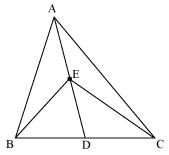
 ABC. Show that
ABC. Show that ar (ABE) = ar (ACE)

Solution 1
AD is median of  ABC. So, it will divide
ABC. So, it will divide  ABC into two triangles of equal areas.
ABC into two triangles of equal areas. 
 ABC. So, it will divide
ABC. So, it will divide  ABC into two triangles of equal areas.
ABC into two triangles of equal areas. 
Question 2
In a triangle ABC, E is the mid-point of median AD. Show that ar (BED) =  ar (ABC)
ar (ABC)
 ar (ABC)
ar (ABC)
Solution 2
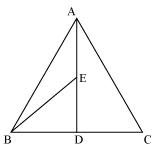 AD is median of
AD is median of  ABC. So, it will divide
ABC. So, it will divide  ABC into two triangles of equal areas.
ABC into two triangles of equal areas. 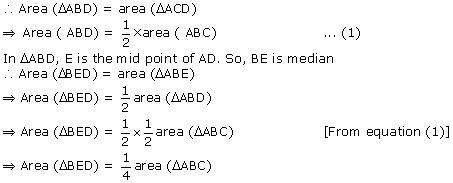
Question 3
Show that the diagonals of a parallelogram divide it into four triangles of equal area.
Solution 3
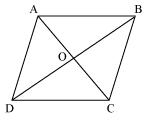

Question 4
In the given figure, ABC and ABD are two triangles on the same base AB. If line-segment CD is bisected by AB at O, show that ar (ABC) = ar (ABD).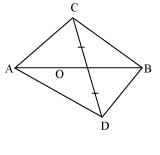

Solution 4

Question 5
D, E and F are respectively the mid-points of the sides BC, CA and AB of a  ABC. Show that (i) BDEF is a parallelogram. (ii) ar (DEF) =
ABC. Show that (i) BDEF is a parallelogram. (ii) ar (DEF) =  ar (ABC) (iii) ar (BDEF) =
ar (ABC) (iii) ar (BDEF) =  ar (ABC)
ar (ABC)
 ABC. Show that (i) BDEF is a parallelogram. (ii) ar (DEF) =
ABC. Show that (i) BDEF is a parallelogram. (ii) ar (DEF) =  ar (ABC) (iii) ar (BDEF) =
ar (ABC) (iii) ar (BDEF) =  ar (ABC)
ar (ABC)
Solution 5
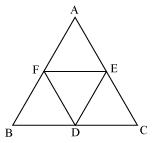 (i) In
(i) In  ABC E and F are mid points of side AC and AB respectively So, EF || BC and EF =
ABC E and F are mid points of side AC and AB respectively So, EF || BC and EF =  BC (mid point theorem) But BD =
BC (mid point theorem) But BD =  BC (D is mid point of BC) So, BD = EF
BC (D is mid point of BC) So, BD = EF Now the line segments BF and DE are joining two parallel lines EF and BD of same length.
So, line segments BF and DE will also be parallel to each other and also these will be equal in length.
Now as each pair of opposite sides are equal in length and parallel to each other.
Therefore BDEF is a parallelogram (ii) Using the result obtained as above we may say that quadrilaterals BDEF, DCEF, AFDE are parallelograms.
We know that diagonal of a parallelogram divides it into two triangles of equal area.
 Now,
Now, Area (
 AFE) + area (
AFE) + area ( BDF) + area (
BDF) + area ( CDE) + area (
CDE) + area ( DEF) = area (
DEF) = area ( ABC)
ABC)  (iii) Area (parallelogram BDEF) = area (
(iii) Area (parallelogram BDEF) = area ( DEF) + area (
DEF) + area ( BDE)
BDE)  Area (parallelogram BDEF) = area (
Area (parallelogram BDEF) = area ( DEF) + area (
DEF) + area ( DEF)
DEF)  Area (parallelogram BDEF) = 2 area (
Area (parallelogram BDEF) = 2 area ( DEF)
DEF)  Area (parallelogram BDEF) = 2
Area (parallelogram BDEF) = 2 
 area (
area ( ABC)
ABC)  Area (parallelogram BDEF) =
Area (parallelogram BDEF) =  area (
area ( ABC)
ABC)
Question 6
In the given figure, diagonals AC and BD of quadrilateral ABCD intersect at O such that OB = OD. If AB = CD, then show that:
(i) ar (DOC) = ar (AOB)
(ii) ar (DCB) = ar (ACB)
(iii) DA || CB or ABCD is a parallelogram. 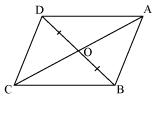
(i) ar (DOC) = ar (AOB)
(ii) ar (DCB) = ar (ACB)
(iii) DA || CB or ABCD is a parallelogram.

Solution 6
 Let us draw DN
Let us draw DN  AC and BM
AC and BM  AC (i) In
AC (i) In  DON and
DON and  BOM
BOM DNO =
DNO =  BMO (By construction)
BMO (By construction) DON =
DON =  BOM (Vertically opposite angles)
BOM (Vertically opposite angles)OD = OB (Given)
By AAS congruence rule
 DON
DON 
 BOM
BOM 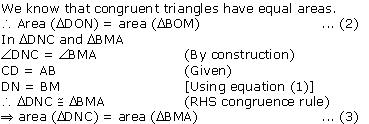 On adding equation (2) and (3), we have
On adding equation (2) and (3), we haveArea (
 DON) + area (
DON) + area ( DNC) = area (
DNC) = area ( BOM) + area (
BOM) + area ( BMA)
BMA)So, area (
 DOC) = area (
DOC) = area ( AOB) (ii) We have
AOB) (ii) We haveArea (
 DOC) = area (
DOC) = area ( AOB)
AOB)  Area (
Area ( DOC) + area (
DOC) + area ( OCB) = area (
OCB) = area ( AOB) + area (
AOB) + area ( OCB) (Adding area (
OCB) (Adding area ( OCB) to both sides)
OCB) to both sides) Area (
Area ( DCB) = area (
DCB) = area ( ACB) (iii) Area (
ACB) (iii) Area ( DCB) = area (
DCB) = area ( ACB)
ACB)Now if two triangles are having same base and equal areas, these will be between same parallels
(DA || CB). Therefore, ABCD is parallelogram
Question 7
D and E are points on sides AB and AC respectively of  ABC such that
ABC such that
ar (DBC) = ar (EBC). Prove that DE || BC.
 ABC such that
ABC such that ar (DBC) = ar (EBC). Prove that DE || BC.
Solution 7
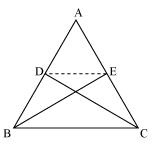
Since,
 BCE and
BCE and  BCD are lying on a common base BC and also having equal areas, so,
BCD are lying on a common base BC and also having equal areas, so,  BCE and
BCE and  BCD will lie between the same parallel lines.
BCD will lie between the same parallel lines.
Question 8
XY is a line parallel to side BC of a triangle ABC. If BE || AC and CF || AB meet XY at E and E respectively, show that
ar (ABE) = ar (ACF)
ar (ABE) = ar (ACF)
Solution 8
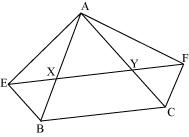 Given that
Given that XY || BC
 EY || BC
EY || BC BE || AC
 BE || CY
BE || CY So, EBCY is a parallelogram.
It is given that
XY || BC
 XF || BC
XF || BC FC || AB
 FC || XB So, BCFX is a parallelogram.
FC || XB So, BCFX is a parallelogram.Now parallelogram EBCY and parallelogram BCFX are on same base BC and between same parallels BC and EF
 AEB
AEBThese are on same base BE and are between same parallels BE and AC
 ACF are on same base CF and between same parallels CF and AB
ACF are on same base CF and between same parallels CF and AB Area (
 ABE) = area (
ABE) = area ( ACF)
ACF)
Question 9
The side AB of a parallelogram ABCD is produced to any point P. A line through A and parallel to CP meets CB produced at Q and then parallelogram PBQR is completed (see the following figure). Show that
ar (ABCD) = ar (PBQR).

ar (ABCD) = ar (PBQR).

Solution 9
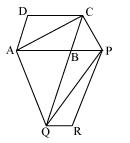
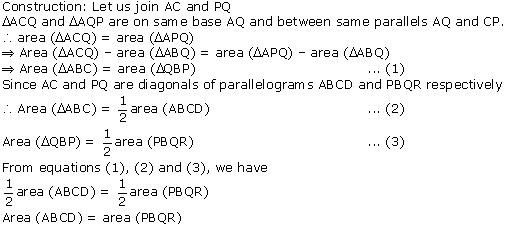
Question 10
Diagonals AC and BD of a trapezium ABCD with AB || DC intersect each other at O. Prove that ar (AOD) = ar (BOC).
Solution 10
 Here,
Here,  DAC and
DAC and  DBC lie on same base DC and between same parallels AB and CD
DBC lie on same base DC and between same parallels AB and CD 
Question 11
In the given figure, ABCDE is a pentagon. A line through B parallel to AC meets DC produced at F. show that
(i) ar (ACB) = ar (ACF) (ii) ar (AEDF) = ar (ABCDE)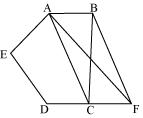
(i) ar (ACB) = ar (ACF) (ii) ar (AEDF) = ar (ABCDE)

Solution 11
(i)  ACB and
ACB and  ACF lie on the same base AC and are between
ACF lie on the same base AC and are between
the same parallels AC and BF (ii) Area (
(ii) Area ( ACB) = area (
ACB) = area ( ACF)
ACF) 
 ACB and
ACB and  ACF lie on the same base AC and are between
ACF lie on the same base AC and are between the same parallels AC and BF
 ACB) = area (
ACB) = area ( ACF)
ACF)
Question 12
A villager Itwaari has a plot of land of the shape of a quadrilateral. The Gram Panchayat of the village decided to take over some portion of his plot from one of the corners to construct a Health Centre. Itwaari agrees to the above proposal with the condition that he should be given equal amount of land in lieu of his land adjoining his plot so as to form a triangular plot. Explain how this proposal will be implemented.
Solution 12
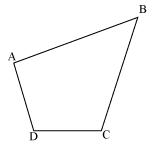 Let quadrilateral ABCD be original shape of field. Join diagonal BD and draw a line parallel to BD through point A.
Let quadrilateral ABCD be original shape of field. Join diagonal BD and draw a line parallel to BD through point A. Let it meet the extended side CD of ABCD at point E. Join BE and AD. Let them intersect each other at O. Now portion
 AOB can be cut from the original field so that new shape of field will be
AOB can be cut from the original field so that new shape of field will be  BCE.
BCE. Now we have to prove that the area of
 AOB (portion that was cut so as to construct Health Centre) is equal to the area of the
AOB (portion that was cut so as to construct Health Centre) is equal to the area of the  DEO (portion added to the field so as to make the area of new field so formed equal to the area of original field)
DEO (portion added to the field so as to make the area of new field so formed equal to the area of original field)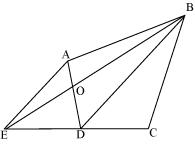
 DEB and
DEB and  DAB lie on same base BD and are between same parallels BD and AE.
DAB lie on same base BD and are between same parallels BD and AE. 
Question 13
ABCD is a trapezium with AB || DC. A line parallel to AC intersects AB at X and BC at Y. Prove that ar (ADX) = ar (ACY).
Solution 13
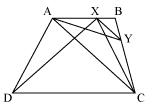

Question 14
In the given figure, AP || BQ || CR. Prove that ar (AQC) = ar (PBR).
Solution 14
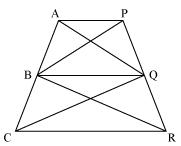

Question 15
Diagonals AC and BD of a quadrilateral ABCD intersect at O in such a way that ar (AOD) = ar (BOC). Prove that ABCD is a trapezium.
Solution 15
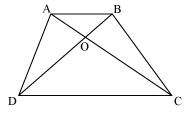

Question 16
In the given figure, ar (DRC) = ar (DPC) and ar (BDP) = ar (ARC). Show that both the quadrilaterals ABCD and DCPR are trapeziums.
Solution 16
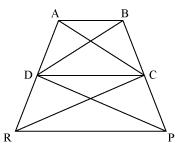
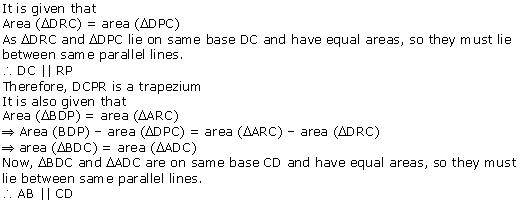 Therefore, ABCD is a trapezium
Therefore, ABCD is a trapezium
No comments:
Post a Comment